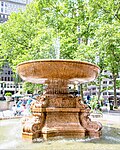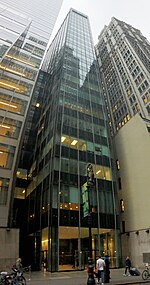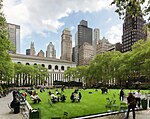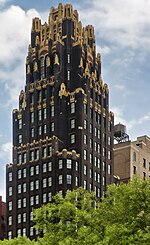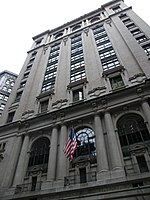Bryant Park Studios

The Bryant Park Studios (formerly known as the Beaux-Arts Building) is an office building at 80 West 40th Street in the Midtown Manhattan neighborhood of New York City, at the corner of 40th Street and Sixth Avenue. The building, overlooking the southwest corner of Bryant Park, was designed by Charles A. Rich in the French Beaux-Arts style. Built from 1900 to 1901 by Abraham A. Anderson, the building is one of several in Manhattan that were built in the early 20th century as both studios and residences for artists. The Bryant Park Studios is 10 stories tall with several mezzanine levels. The lowest two stories of the facade are clad in rusticated blocks of terracotta, while the other stories have pink brick with terracotta and stone decoration. The brickwork of the facade contains both broad and narrow bays, and the northern side facing 40th Street contains large studio windows facing Bryant Park. The Cafe des Beaux-Arts once operated at the ground story and basement. The upper stories had forty units, the largest of which was Anderson's own double-story penthouse. Since the late 20th century, the former studios have served mostly as offices and showrooms, and the lower stories have contained storefronts. The Bryant Park Studios was developed by Anderson, who leased the building to another company in 1920. Anderson lived in his penthouse until his death in 1940, after which his family sold the building. By the late 20th century, the building was converted for office use. The Bryant Park Studios was designated a city landmark by the New York City Landmarks Preservation Commission (LPC) in 1988. The building has been owned since 1980 by the Mountain Development Corporation, which restored the building in the late 1980s and the 2000s.
Excerpt from the Wikipedia article Bryant Park Studios (License: CC BY-SA 3.0, Authors, Images).Bryant Park Studios
West 40th Street, New York Manhattan
Geographical coordinates (GPS) Address Nearby Places Show on map
Geographical coordinates (GPS)
| Latitude | Longitude |
|---|---|
| N 40.7533 ° | E -73.9848 ° |
Address
West 40th Street 80
10018 New York, Manhattan
New York, United States
Open on Google Maps


